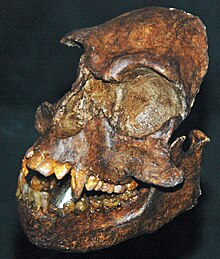Epipliopithecus vindobonensis
|
Epipliopithecus vindobonensis Temporal range: |
|
|---|---|
 |
|
| Epipliopithecus skull | |
| Scientific classification | |
| Kingdom: | Animalia |
| Phylum: | Chordata |
| Class: | Mammalia |
| Order: | Primates |
| Parvorder: | Catarrhini |
| Superfamily: | Pliopithecoidea |
| Family: | Pliopithcidae |
| Subfamily: | Pliopithecinae |
| Genus: | Epipliopithecus |
| Species: | E. vindobonensis |
| Binomial name | |
|
Epipliopithecus vindobonensis |
|
Epipliopithecus vindobonensis is an extinct species of Pliopithecoidea primate recovered from the Middle Miocene deposits of Devínska Nová Ves fissure in western Slovakia.Epipliopithecus is the one of the few pliopithecoids for which both cranial and post-cranial fossil material has been recovered. Most pliopithecoids are known only from fossilized teeth, whereas Epipliopithecus is known from three nearly complete skeletons. As such, Epipliopithecus has greatly informed the modern understanding of pliopithecoid anatomy, locomotion, and phylogeny.
Epipliopithecus was discovered and described by Helmuth Zapfe and Johannes. The fossil material was found in a fissure deposit near Nová Ves (Slovakia) in the southern part of the Carpathian Mountains. The rock surrounding the fissure is limestone and dolomite of Jurassic age. The fissure deposit itself is clearly much younger, as has been demonstrated to date to the lower middle Miocene (Helvetian), approximately 15.5 million years old.
Zapfe and Hürzeler originally gave the specimens the name Pliopithecus (Epipliopithecus) vindobonensis. Epipliopithecus denoted a sub-generic distinction which implied that this species was ancestral to later pliopithecoids like Pliopithecus antiquus and Pliopithecus platyodon. With the subsequent discovery of many more pliopithecoid species across Eurasia, the precise phylogeny of these species has become less certain. Given the unique morphology of Epipliopithecus, however, researchers have elevated Epliopithecus from a sub-genus to a genus.
Epipliopithecus has a number of morphological characters that demonstrate its primitive phylogenetic position relative to living catarrhines. One of these most notable characters is found in the outer ear morphology of Epipliopithecus. New World monkeys and basal anthropoids (i.e. Aegyptopithecus, Parapithecus, and Apidium) have a bony ectoympanic ring, whereas crown catarrhines (Old World monkeys and apes) have a completely ossified ectotympanic tube. Epipliopithecus possesses an intermediate morphology in the form of a partially ossified ectotympanic tube. Some authors have argued this morphology is best interpreted as an intermediate evolutionary step between an ectoympanic ring and ectotympanic tube. Others have suggested it may be an intermediate developmental morphology, as a similar condition is seen in some extant juvenile catarrhines.
The snout of Epipliopliopithecus is reduced in length compared to earlier catarrhines like Aegyptopithecus. The crania is globular shape, somewhat similar to a gibbon. These traits, combined with seemingly similar dental characteristics, lead some early researchers to suggest a close evolutionary relationship between Pliopithecoidea and Hylobates. This hypothesis has largely fallen out of favor, mostly because of the primitive nature of the skeleton of Epipliopithecus.
...
Wikipedia
